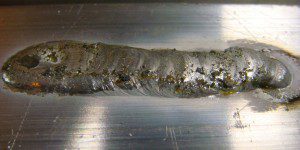Column
Filter by Process Zone:
How to Select the Right Flap Disc

With all the benefits afforded by flap discs, it is important to know how to select the right one by understanding all the variables and how they apply to your metal fabricating application. Here are the five variables that will help you pick the correct one.
Robotic Applications for Cladding and Hardfacing

Competitive pressures cause manufacturers to research advancements in hardfacing and cladding for surfacing applications that can reduce wear over 50 percent and increase production throughput over 30 percent. Selecting the method best-suited to a particular application involves balancing cost against performance.
BECOMING FAMILIAR WITH THE X-FACTOR
Ideal for use when welding boilers, process piping, heat exchangers and other applications subject to high service temperatures for long periods of time, Tim Hensley of Hobart Brothers introduces a formula that helps determine a weld’s resistance to the brittleness that occurs when the weld is slowly cooled through a certain temperature range.
GOING FOR GREEN LIGHT: REDUCING LASER SETUP TIMES TO KEEP THE BEAM ON
Green light time is the way to make money operating a machine tool, and it never hurts to go back and review some basic principles for improving productivity in a laser fabricating process. With an eye toward keeping that light on longer, Tom Bailey of Trumpf looks at a few simple strategies that can pay off.
PULLING IT ALL TOGETHER
Approaching Safety Holistically (Part Two): While safety training is important, Phil La Duke of Rockford Greene explains how the real payoff for investing in training comes from monies spent on imparting the most basic skills workers will need to do their jobs.
CORROSION OF PIPE WELDS MADE WITH METAL-CORE WIRE
Regis Geisler of Lincoln Electric analyzes the recent occurrence of this situation at a fabrication site, then recommends some remedies for mitigating the effects.
ENERGY EFFICIENCY PLUS FULL DATA TRACKING – A CNC CHRISTMAS PRESENT!

Randy Pearson of Siemens Industry shows how today’s CNC not only puts a greater degree of energy efficiency at your fingertip, it can also provide you more usable data for running your entire shop or machining department . . . yes, Virginia, there IS a Santa Claus!
Tallying True Costs
When a machine spindle goes down, much more is involved than simply the bottom-line review of a repair bill or the purchase price of a new spindle. Additional underlying costs include more than dollars. Ed Zitney of SKF Machine Tool Services examines what you can do to help save time and money when a good spindle fails.
APPROACHING SAFETY HOLISTICALLY
After a process is stable and compliant, safety should focus on worker and process capability by diverging into worker skills and equipment maintenance. Phil La Duke of Rockford Greene reveals why there is no need to spend lots of time trying to improve workplace safety through worker training and total productive maintenance when there are many other low-cost actions that can be quickly deployed.
Staying One Up: New Ways of Doing Business
It is useless to worry about whether the economy is getting better or worse. Instead, focus on out-marketing your competition. Here are several effective ways to do just that.
How to Pick the ‘Right’ Angle Abrasive
New products have expanded the right angle grinder’s use, but they have also added some complexity to the selection process to match the right product to the right material and application while meeting the criteria most important to the end user. Dave Long of Norton Abrasives shares some helpful selection tools to simplify the process.
10 Common TIG Problems and Solutions

Here are some descriptions of common TIG mistakes and basic tips on how to prevent these errors from happening.















